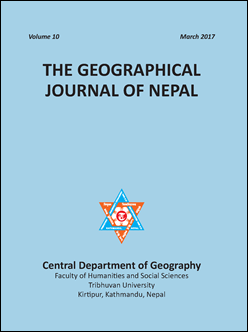Revisit to functional classification of towns in Nepal
DOI:
https://doi.org/10.3126/gjn.v10i0.17387Keywords:
Basic and non-basic components, goods and services, functional base, incorporated towns, range, threshold populationAbstract
The present study on functional classification of the towns in Nepal is a revisit to the study made in 1980 applying the similar methodology. The previous study was based on census data of 1971 and the present study on census data of 2011. The percentages of surplus labour force in proportion to national level were computed considering five activities groups involved in non-agricultural sectors. Then, the arithmetic means of each activity group were calculated and the standard deviations from the means were taken for measuring the functional specialization.The study revealed that both the degree of urbanization and level of functional specialization have considerably increased during a period of four decades. There were only 16 towns in 1971, which increased to 58 in 2011. The number of specialized towns has increased by six folds from 4 in 1971 to 26 in 2011. The level of urbanization has now been a prominent phenomenon as compared to that in 1971. In 1971, even the then large towns were with high agricultural labor force. Now, the proportion of agricultural labor force has declined considerably. However, agriculture labor forces constitute to be dominant in more than 15 smaller towns. It indicates that urban economic base is not being taken into account while incorporating places as municipalities in several cases.
The Geographical Journal of Nepal Vol. 10: 15-27, 2017
Downloads
814
4042
Downloads
Published
How to Cite
Issue
Section
License
© Authors




